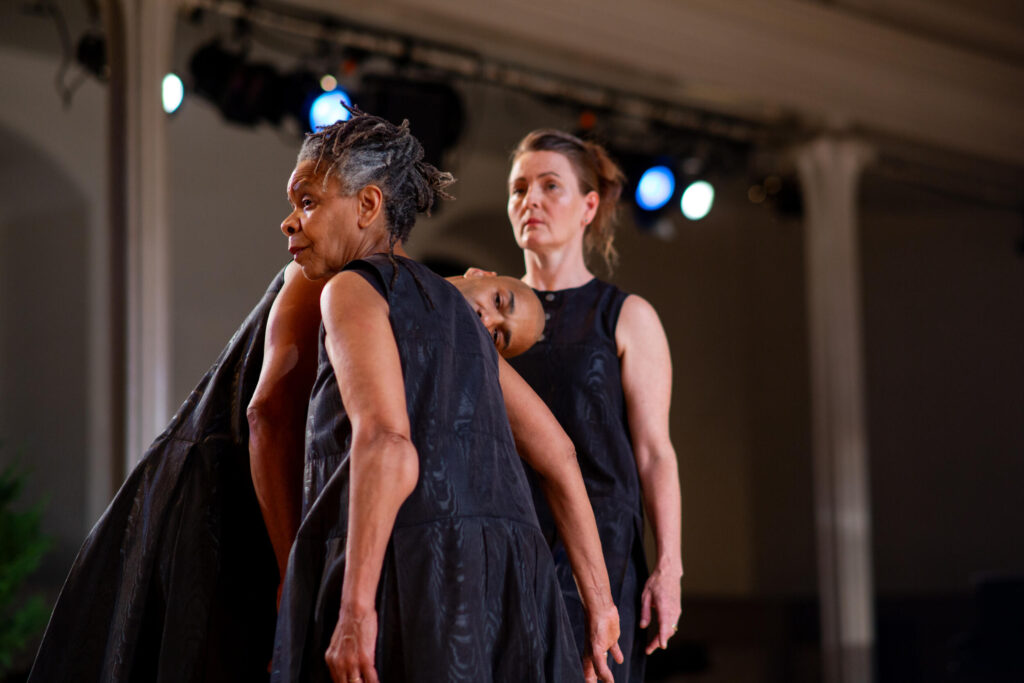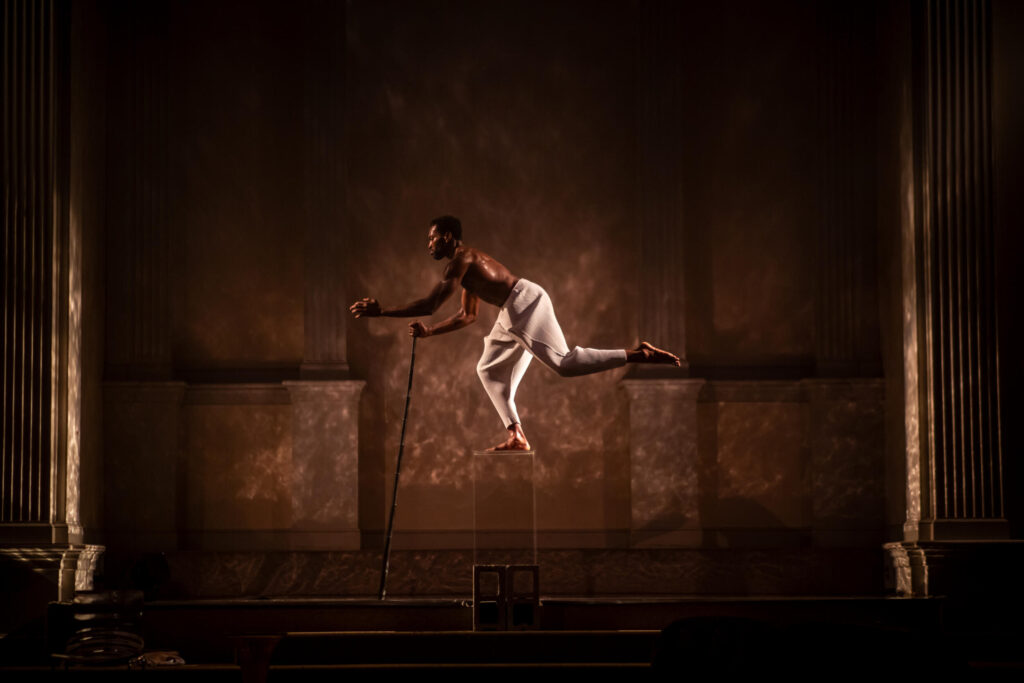Shapeshifting as Practice: Rituals of the Body in Time with Bebe Miller and Vinson Fraley By Sarah Cecilia Bukowski
September 4, 2024

Indifferent Forest (early iteration), Danspace Project, 2024. Presented as part of Platform 2024: A Delicate Ritual, curated by Kyle Abraham. Photo: Rachel Keane/courtesy of Danspace Project.

This reflection on a shared evening with Bebe Miller and Vinson Fraley cites the performances, the June 8th Platform 2024 closing Conversation Without Walls with Fraley and Miller, and their transcribed conversation that is a part of the Platform 2024 catalogue, A Delicate Ritual.
Read or listen.
Shapeshifters hold a powerful presence in mythologies and folkloric traditions worldwide. Whether as deity, spirit, trickster, or monster, shapeshifters rely on manipulations of perception—spatial, temporal, and material—to enact social or moral imperatives and reveal deeper metaphysical truths. By traversing space and time in mystical or subversive ways, shapeshifting grants access and agency to collapse the void between self and other and approach a harmonic oneness of being. Artists harness the power of shapeshifting to distort and reflect surfaces and create channels to venture beyond the known. Bebe Miller and Vinson Fraley are two such artists who offer dual meditations on the transcendent force of empathy in a shared evening to close Danspace Project’s Platform 2024: A Delicate Ritual.
Guest curator Kyle Abraham grounds A Delicate Ritual in questions of embodied practice in relation to nature, time, and humanity:
How does nature’s relationship with humanity communicate/jostle/live in your body?
How present is a history of love in your relationship to or ritual of prayer?
How does change affect your relationship to ritual and prayer?
These open prompts and broad themes allow these artists to respond individually and in dialogue with each other from a place of vulnerability, opening inward and outward through intuition and affinity. What results are two works of striking textural contrast and disciplinary range that shapeshift at grand and small scales to activate the body as a conduit for rituals of surrender, affirmation, and community.
In their exchanges in the Platform catalogue and Conversations Without Walls program, Miller, a veteran performer and dancemaker, and Fraley, a seasoned performer and relative newcomer to dancemaking, muse candidly on their artistic practices and motivations. Miller’s patience seems to be her greatest asset—perhaps one that can only come with lived time—and she uses it to shape a relationship to form as an elusive architecture composed of dynamic elements. Through structured improvisation, Miller treats forces of pressure, resistance, friction, and gravity with regard, recognition, and release anchored in an abiding awareness that opens a field of risk taking through trust and curiosity. Fraley takes a collage-based approach to craft a mosaic of movement, sound, material, and technology aimed at framing the ephemeral. The younger artist admits to wrestling with the need to display and perform his copious gifts as a mover and vocalist, and reflects on his elder’s capacity to slow down, listen, and play.
Miller’s Indifferent Forest draws inspiration from her natural surroundings—a Douglas fir forest on Vashon Island in the Pacific Northwest—and invites longtime collaborators Angie Hauser and Darrell Jones into explorations of interdependence and self-reliance. The forest sends representatives: a large potted tree rests on a wheeled dolly and small tablets scattered around the space display images of trees and sky, as if the dance wants to root back to the landscape as its original witness. A snippet of text (Katie Mack’s The End of Everything) delivered frankly by Miller provides a metaphysical frame, and a bit of Bach ushers us into a subtly kinetic dancescape that patiently coaxes our attention.
The trio begins and continually returns to a meditation on “the weight at risk”[1] as the performers fall almost imperceptibly from momentary stillness. These subtle moves unleash cascades of shifting shapes as stance becomes drop becomes contact becomes weight sharing becomes surrender becomes resilience. Their shared improvisational virtuosity illuminates minute textures and sustained tones; they are precisely contained yet never stilted as they spiral, slice, and stutter with soft-edged clarity of purpose. Their consummate trust is palpable in every point of contact—even in the air between them—their senses attuned and receptive to an exploratory certainty.
Miller and her shapeshifting collaborators are also masters of time, which seems to evaporate in the power of their presence: the stretched and spiky rhythms of their entanglements and departures traverse the grandness of geological time and the precious, fleeting smallness of our human scale. It is this very impermanence that makes us precious, this “regular person time,”[2] as Miller says, that lives in and through our bodies. In the play of these timescales the bodies dancing before us craft an intimacy devoid of theatrical illusion as they meander together with generous interiority and clear-eyed detachment, leaving variegated contrails in their wake. In their hands, shapeshifting and time bending are not so supernatural; they are the ingredients of a “mundane ritual"[3] of being through shared embodiment.
The intensity of Miller’s work is deceptive; though equanimous and unhurried, she nevertheless commands an engaged viewership. At its close, we the viewers step equally clear-eyed into the church courtyard’s warm evening breeze, only to reenter the sanctuary engulfed in haze.
Fraley’s solo work Pneuma—meaning vital breath, spirit, or soul—unfolds as a tour de force of stunning range and rare dramatic sensitivity. Through a series of loosely woven, tonally distinct episodes Fraley offers his body, voice, and vision to express facets of his worldview through iterative acts of shapeshifting the ephemeral self. Fraley points to a tension between the performative need to display his prodigious talents and the quietly centered assurance of elders like Miller. In every conversation between the two artists—on stage, on the microphone, and on the page—Fraley seems fortified by the calm yet persistent curiosity that drives Miller’s craft, and his modulations of effort, ease, and wonder owe much to this attentive stance.
In this spirit, Pneuma opens with Fraley curled on a moss runner inspired by Miller’s 1989 Rain, which explores the tension of opposites—up and down, nature and “opulence”—in which Fraley recognizes the power of “see[ing] a Black woman have that kind of relationship, in theater, to the ecological.”[4] In Fraley’s work, the artist floats in two distinct dimensions at once: his body in the flesh rolls with and against gravity as multiple virtual avatars of himself fall in slow motion through the sky projected above him. In this world materiality and virtuality converse like two sides of a coin as accompanist and DJ Aku Orraca-Tetteh shapes a sonic arc that shifts seamlessly between a grand piano and digital tools. Objects lend texture and drama: a flaring tropical leaf balanced delicately in the palm of Fraley’s hand, a long black bamboo pole swung in wide circles, a diaphanous white robe that trails his rhythmic jogging leaps. Cinder blocks, a glass pedestal, and two boulders complete an arena for these many contrasts to mingle in a fluctuating colorscape of light and shadow.
Text, song, and movement throughout probe themes of exertion, rest, and care. Fraley sings and dances from the soul, outwardly tender and brazen in turn while tethered to a spirit that softens these extremes. The articulate range of his every joint and gesture matches a voice that sails radiantly through octaves, undeniably virtuosic yet never ostentatious. He catches and releases undulating geometries and striking symmetries through acts of celebration, remembrance, admonition, and deep questioning. Wheeling circles recur in every imaginable physical plane and affective register, their indelible momentum like the inevitability of time. By interrogating religious tradition and invoking prayer, Fraley shapeshifts into a simultaneous awakening of ancestry and futurity in the precarity of the present moment.
Miller and Fraley tread through deeply personal expressions of embodiment to traverse a spectrum that includes and resonates with us all. Their delicately shapeshifting rituals of transcendence open a portal to slippery notions of space, time, and being as engines for empathy. Breathtaking in their momentary beauty, the vestiges of their presence echo into every new breath we take.